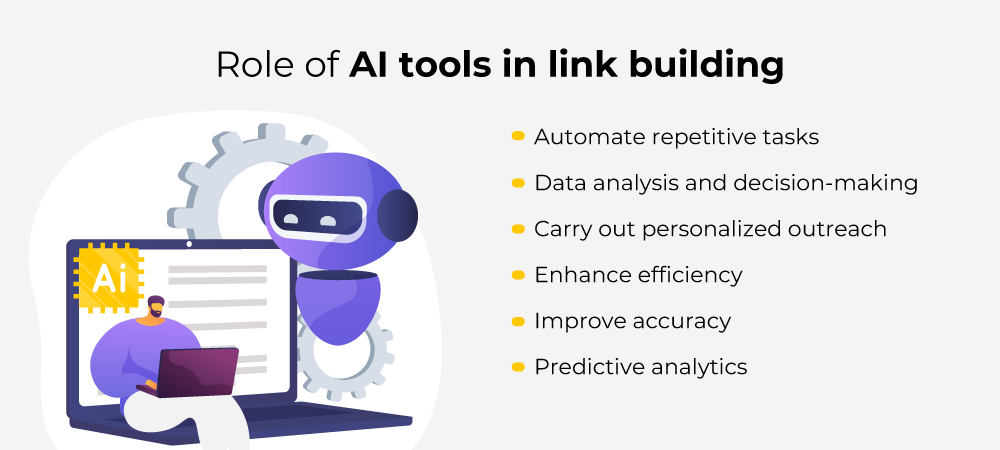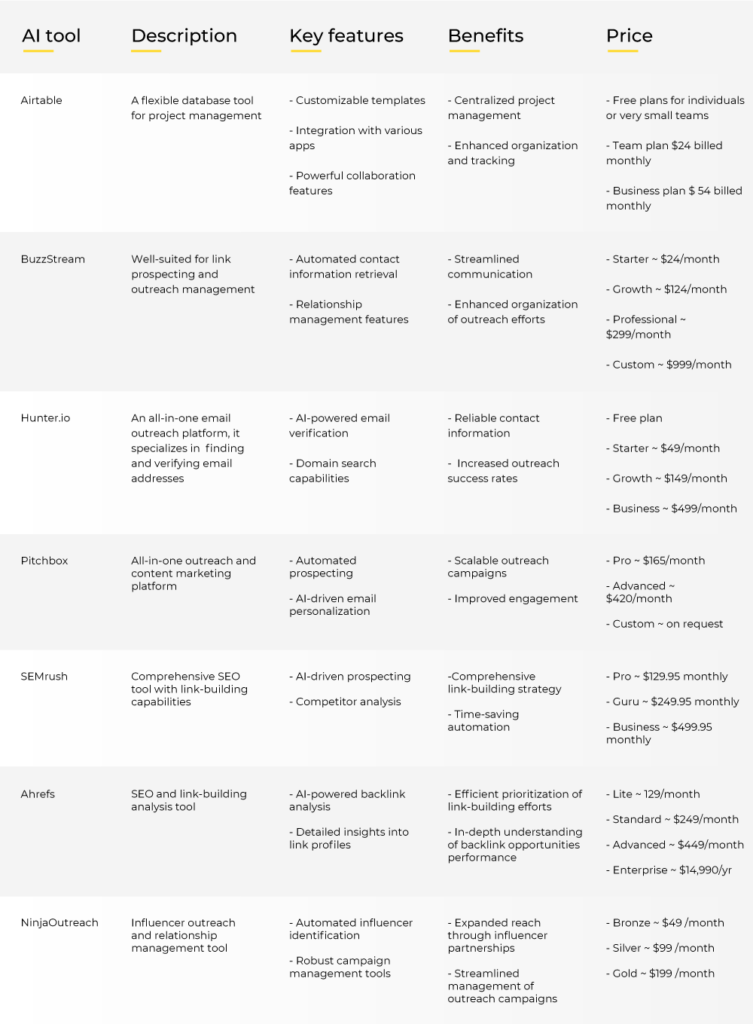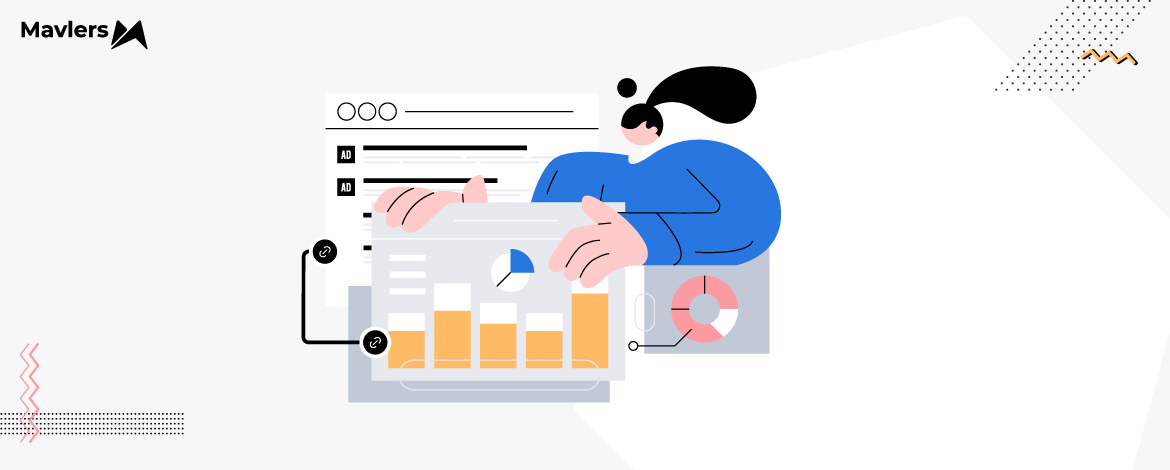So, it’s a busy Monday morning, and your inbox is overflowing.
Your to-do list? Prospecting for backlinks, sending outreach emails, tracking responses, analyzing link quality, and somehow keeping your SEO campaign ROI from flatlining. It’s exhausting, right?
Now imagine a world where the grunt work is handled for you, an assistant who never sleeps, never misses a follow-up, and knows exactly which websites will give your SEO the biggest boost.
Welcome to the world of AI-powered link building. And no, it’s not science fiction. It’s very much real, and it’s reshaping how digital marketers, SEO professionals, and agency owners work in 2025.
In this guide, we won’t just list AI tools; we’ll show you how to integrate them into your workflow, turbocharge your campaigns, and stay ahead of the competition, all while preserving the human touch.
Why we need AI in link building
If you’ve ever spent an entire afternoon sifting through websites to find prospects, you are familiar with the pain. Traditional link building can be slow, repetitive, and exhausting.
AI doesn’t replace your skills; it amplifies them. Here’s how it helps:
- Automates tedious tasks, including prospecting, email collection, and follow-ups. Done.
- Crunches data faster than any human could: Domain authority, relevancy, backlink quality, you name it.
- Personalizes outreach at scale: Instead of “Dear Sir/Madam,” your emails actually feel human.
- Predicts what works: Spot trends and high-value opportunities before your competitors even see them.
The best part is that you spend less time wrestling with spreadsheets and more time thinking creatively.

Our go-to tools for AI link building
Here are the tools we use (and recommend) to make campaigns run smoother without losing the human touch:

However, don’t just pick a tool because it’s popular. Consider workflow, ease of use, and what best fits your process.
How to use AI in your link-building workflow
Integrating AI tools for backlinks strategy can significantly enhance efficiency, accuracy, and overall effectiveness. Here’s a step-by-step guide on how to implement AI tools in your link-building process:
Step 1: Assess your link-building needs
1. Evaluate current strategy:
Begin by reviewing your existing link-building strategy. Identify areas where AI tools can add value. Consider factors such as the outreach volume, the campaigns’ complexity, and the need for data analysis.
2. Define objectives:
Clearly define your goals. Determine whether you want to increase the number of backlinks, improve link quality, or enhance outreach efficiency. Having clear objectives will help you choose the right AI tools.
3. Identify pain points:
Pinpoint the specific challenges you face in your current link-building efforts. This could include difficulties in prospecting, time-consuming outreach processes, or managing large datasets.
Step 2: Select the right AI tools
1. Research available tools:
Research AI tools that cater to your specific needs. Some popular options include Airtable, BuzzStream, Hunter.io, Pitchbox, SEMrush, Ahrefs, and NinjaOutreach. (Discussed in detail in the table above)
2. Evaluate features and benefits:
Compare the features and benefits of different tools. Consider factors such as ease of use, integration capabilities, cost, and scalability. Use the comparison table provided in this guide to help make your decision.
3. Trial and testing:
Many AI tools offer free trials or demos. Test a few options to see which best fit your workflow and deliver the desired results.
Step 3: Integrate AI tools into your workflow
1. Set up and configuration:
Once you’ve selected your AI tools, set them up and configure them according to your needs. This may involve importing existing data, setting up integrations with other tools, and customizing settings.
2. Training and onboarding:
Train your team on how to use the new AI tools effectively. Provide resources such as tutorials, user guides, and support contacts to help them get up to speed quickly.
3. Create Standard Operating Procedures (SOPs):
Develop SOPs that outline how to use AI tools in your link-building process. This will ensure consistency and efficiency in your workflows.
Step 4: Implement AI tools
1. Prospecting:
Use AI tools to automate the prospecting process. AI can help you identify high-quality link opportunities by analyzing relevant websites, content, and backlink profiles.
2. Outreach:
Leverage AI to automate and personalize your outreach efforts. Tools like Pitchbox and BuzzStream can help you craft personalized emails and manage communication with prospects.
3. Content management:
AI can assist in content management by identifying content gaps, suggesting relevant topics, and ensuring content is optimized for different languages and regions.
4. Link monitoring:
Use AI to monitor your backlinks’ performance. Tools like Ahrefs and SEMrush provide insights into backlink quality, anchor text distribution, and their overall impact on your SEO performance.
Step 5: Best practices
1. Regular script audits and updates:
Regularly review and update the scripts and automation workflows to keep them optimized. This ensures that your AI tools are functioning at their best and adapting to any changes in search engine algorithms.
2. Combining AI insights with human creativity:
While AI can handle data analysis and automation, human creativity is essential for crafting compelling outreach messages and developing innovative link-building strategies. Use AI insights to inform your decisions, but rely on your team’s creativity to execute them effectively.
3. Monitoring and adjusting AI tool performance:
Continuously monitor the performance of your AI tools. Use analytics and feedback to identify areas for improvement and make necessary adjustments to optimize your link-building efforts.
Step 6: Ongoing monitoring and optimization
1. Set Up regular monitoring and reporting:
Establish a routine for monitoring the performance of your link-building campaigns. Use AI tools to generate reports on key metrics such as traffic, rankings, and conversions.
2. Analyze performance metrics:
Analyze the data provided by your AI tools to assess the effectiveness of your link-building strategy. Look for trends, patterns, and areas for improvement.
3. Continuous improvement:
Make continuous improvements based on the data and insights gathered from your AI tools. Adapt your strategy to changes in search engine algorithms and market trends to maintain your competitive edge.
Why humans still hold the edge
While AI is impressive, it’s not the whole story. No machine can replicate the nuance, intuition, and gut instincts that humans bring to the table.
When we say that, think about this:
- Building relationships that actually convert: AI can send emails, but it can’t pick up on a subtle tone, respond to hesitations, or nurture a connection over time. Humans excel at turning a cold prospect into a genuine partnership.
- Crafting messages that resonate: Automated templates are fine, but nothing beats a message tailored with humor, insight, or shared understanding of an industry challenge. That human touch is what makes someone care enough to link back.
- Judging link quality like a pro: AI can tell you a site has high authority, but it can’t discern whether the backlink fits your brand voice, your audience, or your long-term SEO strategy. That judgment call? 100% human.
In summary, AI is the engine, but humans are still the driver. Without your insight, creativity, and decision-making, even the most sophisticated AI workflows end up as just “pretty spreadsheets.”
2025 SEO trends you can’t afford to ignore
If you thought SEO was just about keywords and backlinks, think again. 2025 is all about AI-powered search, generative SERPs, and voice-first discovery. The rules are changing and fast.
Here’s what’s really shifting:
- Answer-focused content wins: Users and AI assistants want quick, clear answers. Structure your content so that your key insights can be surfaced immediately in snippets.
- Entity-based thinking matters: Don’t just sprinkle keywords; show connections between concepts like AI, link building, and broader SEO strategy, so search engines understand the full story.
- Rich results aren’t optional: Tables, step-by-step guides, visuals, and workflow diagrams aren’t just nice-to-haves; they help your content stand out in SERPs and get noticed by AI assistants.
- Keep it conversational: People (and voice assistants) prefer natural, human-friendly phrasing. Instead of “AI link-building automation tools,” try “How can AI actually help me build backlinks?” It reads like a conversation, not a robot report.
2025 SEO isn’t just about playing by old rules; it’s about speaking the language of humans and machines, simultaneously. Those who do it well will dominate the SERPs, the AI answer boxes, and, most importantly, the attention of real humans.
FAQs: Honest answers you actually need
Q: Can AI generate high-quality backlinks all by itself?
A: Nope. AI identifies opportunities and streamlines tasks, but it can’t replace human judgment in assessing relevance, brand fit, or content quality.
Q: Are AI link-building tools safe to use?
A: Absolutely, if you stick to reputable platforms and avoid spammy, mass outreach tactics. Think of AI as a super-efficient assistant, not a shortcut to low-quality links.
Q: How much do these AI tools cost?
A: There’s a wide range. Some tools are free, while premium platforms can run anywhere from $50 to $500+ per month. The ROI comes from the time saved and the quality of links earned.
Q: Will AI make my outreach feel robotic?
A: Only if you let it. AI can draft messages, but humans are needed to add nuance, context, and a personal touch that makes prospects care.
Q: How often should I check on AI-powered campaigns?
A: Treat it like a living system: weekly for outreach monitoring, monthly for analyzing metrics, and quarterly for strategy adjustments.
Q: Can AI replace a link-building team entirely?
A: Not a chance. AI scales tasks, but humans drive quality, strategy, and relationships—the aspects that make backlinks truly valuable.
Q: Which tasks should always stay human-led?
A: Crafting messaging, building relationships, making strategic decisions, and creating compelling content. Those require creativity, empathy, and insight, things AI can’t replicate.
Q: How do I measure if AI is actually helping my link-building?
A: Track metrics like link acquisition speed, response rates, domain authority of backlinks, referral traffic, and overall impact on rankings. The goal is not just to have more links, but to have better, more meaningful links.
The road ahead
You are now quite familiar with automating your link-building process using AI tools. If you’d like to read more about the tools and tech stack we at Mavlers deploy to run and analyze SEO campaigns, you can do that, too!



Dharti Joshi - Subject Matter Expert (SME)
Dharti Joshi is a dynamic professional who has been working as an Assistant Manager - Search Client Operations at Mavlers for 9 years. Throughout her career at Mavlers, she has demonstrated a commitment to excellence, consistently delivering results that drive business growth and success. Her collaborative approach and strong leadership abilities make her a valuable asset to the team, inspiring those around her to strive for professional greatness. Outside of her professional pursuits, Dharti is deeply passionate about giving back to her community. Whether through volunteer work or mentorship programs, she seeks to impact every endeavor of hers positively!
Naina Sandhir - Content Writer
A content writer at Mavlers, Naina pens quirky, inimitable, and damn relatable content after an in-depth and critical dissection of the topic in question. When not hiking across the Himalayas, she can be found buried in a book with spectacles dangling off her nose!
SEO on a Budget: The Best Free and Low-Cost Tools for 2024
Email Testing Made Easy with Cloud Pages in SFMC